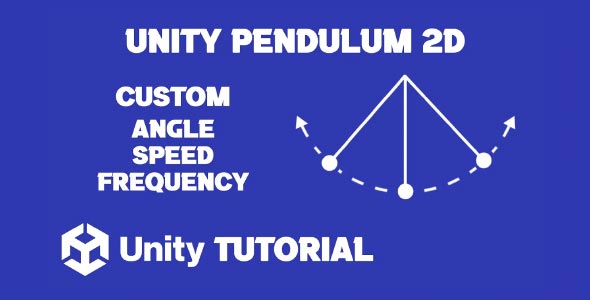If you are searching how to make Unity 2d pendulum effect, this tutorial will help to add realistic and smooth motion to your projects to enhance gameplay and visual appeal. Whether you’re creating a swinging chandelier, a clock’s pendulum, or a physics based puzzle element, mastering the pendulum effect in Unity 2D can significantly enhance your game’s immersion and interactivity. This article will explore the fundamentals of pendulum motion, practical tips, and best practices to help you achieve smooth and natural movement without complicated coding.
Understanding how to create a pendulum effect is essential for developers interested in physics simulations or dynamic animations. From a simple swing to more complex interactions, the principles remain the same, relying on oscillatory motion governed by forces like gravity and tension. By following this pendulum tutorial, you can bring authentic, responsive movements to your objects, improving both gameplay and visual appeal.
What Is A Pendulum And Why Use It In Unity 2D?
A pendulum is a weight suspended from a pivot that swings back and forth under the influence of gravity. In 2D games, simulating this motion adds realism and natural physics behavior to objects. The pendulum effect captures oscillations that can be slow and deliberate or quick and energetic, depending on the parameters you set.
Using a pendulum in your game can serve many purposes. It can act as a decorative element to enhance your scene’s atmosphere, or it can form a key gameplay mechanic, such as timing challenges, traps, or puzzles. Understanding the underlying motion helps in designing responsive and believable pendulum movements that feel intuitive to the player.
Pendulum Unity Tutorial
When following a pendulum Unity tutorial, it’s important to grasp the basic motion principles. The pendulum swings in an arc, moving from one extreme angle to another and back again. This motion follows periodic behavior, often represented by sine or cosine functions that describe smooth oscillations.
The tutorial typically guides you through setting up the pivot point, adjusting the length of the pendulum arm, and controlling swing speed. Fine tuning these parameters influences how the pendulum reacts to forces like gravity and damping, which slows down motion over time.
In practical terms, the tutorial emphasizes smooth transitions between positions, avoiding abrupt stops or unnatural jerks. This attention to detail makes the pendulum’s movement more visually appealing and realistic. Additionally, understanding the role of the pivot and gravity ensures your pendulum behaves correctly within the game’s physics environment.
Understanding Unity Pendulum Physics 2D
To achieve authentic motion, it’s critical to understand the physics behind a pendulum. The Unity pendulum physics 2d system simulates forces such as gravity pulling the pendulum down and tension in the arm that restricts its path. These forces create the characteristic back and forth swing.
In Unity’s 2D physics engine, you can apply forces or use joints to mimic these constraints. The physics engine calculates the pendulum’s position over time, ensuring natural motion without manually animating every frame. This makes it easier to create dynamic and interactive pendulums that respond to other objects and player input.
Damping also plays a vital role. It simulates friction or air resistance, gradually reducing the pendulum’s energy until it eventually comes to rest. Properly adjusting damping parameters in your physics setup prevents endless swinging and keeps the motion believable.
The pendulum effect can be adapted to various objects in your game. For example, a swinging lantern in a spooky environment can add atmosphere, while a swinging axe in a trap room introduces gameplay challenge. The tutorial helps you customize the pendulum’s speed, arc, and responsiveness to fit each context.
Moreover, combining pendulum motion with collision detection greatly enhances interactivity. When a pendulum can knock over objects or trigger switches, it adds an exciting layer of depth to your game design. However, this kind of integration requires careful tuning of physics parameters. Without proper adjustments, the pendulum’s behavior might become unstable or erratic. That’s why understanding how to make Unity 2d pendulum effect correctly is crucial. It ensures all interactions feel smooth and believable within your game world.
Using the pendulum effect creatively allows you to craft unique mechanics. You might design puzzles where timing the swing is essential, or create moving platforms that oscillate smoothly. This versatility makes the pendulum a valuable tool in your Unity 2D toolkit.
Tips For Fine Tuning Pendulum 2D Effect
Getting the pendulum motion just right involves balancing several factors. Length, mass, gravity, and damping all influence how your pendulum swings. Testing and iteration are key to finding the perfect feel. Following a detailed pendulum Unity tutorial can make this process much easier by showing you exactly what to adjust for the best results.
Adjust the pendulum arm length to control the swing radius. A longer arm results in wider, slower swings, while a shorter arm produces faster, tighter oscillations. Mass affects momentum, so heavier pendulums will feel more forceful and resistant to external influences.
Gravity in Unity’s 2D physics engine can be tweaked globally or per object to simulate different environments, such as underwater or low gravity worlds. Damping must be fine tuned to ensure the pendulum doesn’t swing forever or stop too abruptly.
Always consider the player’s experience, pendulum speed and swing range need to match your game’s pacing and challenge level. Generally, smooth and consistent swings enhance gameplay, while erratic or excessively fast movements can lead to frustration. Using Unity pendulum physics 2d principles allows you to fine tune these aspects for balanced and enjoyable motion.
While physics controls motion, layering animation and sound can elevate the pendulum’s impact. Subtle creaking sounds synchronized with swings add realism and immersion. Visual effects, such as slight motion blur or shadow movement, enhance the sense of motion.
Animating the pendulum alongside other environmental elements can create cohesive scenes. For example, nearby foliage might sway in sync with the pendulum’s rhythm, reinforcing the feeling of natural motion.
These details contribute to player engagement, making your pendulum not just a functional object but part of a living, breathing game world.
Common Challenges And How To Overcome Them
Developers often face issues like jittery movement, unrealistic swinging speeds, or pendulums clipping through other objects. These problems typically arise from incorrect physics settings or pivot placement.
To solve jittering, ensure the pivot point is accurately set and avoid conflicting forces acting on the pendulum. Using physics joints like hinge joints correctly can prevent unnatural rotation.
Unrealistic speeds can be controlled by adjusting gravity and damping values. Always test in-game to observe how these changes affect behavior under different conditions.
Avoid clipping by properly configuring colliders and rigidbodies on the pendulum and surrounding objects. This ensures smooth interactions and prevents frustrating visual glitches.
Conclusion
Learning how to make Unity 2d pendulum effect is essential for developers aiming to bring authentic motion and dynamic interaction into their games. A well executed pendulum effect not only adds realism but also opens up creative possibilities for gameplay mechanics and environmental storytelling. By grasping the core principles behind pendulum motion, you can craft smooth and engaging animations that enrich your game world.
Following a comprehensive pendulum Unity tutorial can provide valuable insights into setting up your pendulum correctly. Tutorials guide you through crucial steps like establishing pivot points, adjusting swing speed, and managing damping. This foundation allows you to fine tune the behavior to suit your game’s unique style and mechanics, whether you’re aiming for subtle atmospheric effects or intense physics based challenges.
Finally, mastering Unity pendulum physics 2d is key to achieving natural and responsive movement. Leveraging Unity’s physics engine to simulate forces such as gravity, tension, and damping helps create realistic swings that respond dynamically to player interactions and environmental factors. Combining these physics principles with thoughtful design ensures your pendulum effects contribute meaningfully to both gameplay and immersion.
Script: Pendulum.cs
using UnityEngine;
public class Pendulum : MonoBehaviour
{
public float swingAngle = 30f; // Maximum swing angle
public float swingSpeed = 1f; // Speed of the swinging
public float swingFrequency = 1f; // Frequency of the swing motion
private float currentAngle;
private float time;
void Start()
{
// Ensure the rod is set at the initial position
currentAngle = 0f;
time = 0f;
}
void Update()
{
// Update the time based on swing speed
time += Time.deltaTime * swingSpeed;
// Calculate the current angle using a sine wave for smooth oscillation
currentAngle = swingAngle * Mathf.Sin(time * swingFrequency);
// Apply rotation
transform.rotation = Quaternion.Euler(0, 0, currentAngle);
}
}When working on a pendulum effect in Unity 2D, adding atmospheric details like weather can really elevate your scene. For instance, incorporating rain can create a more immersive and dynamic environment. If you’re interested in enhancing your project this way, this Unity 2D Rain Effect tutorial offers a step-by-step guide to adding realistic rain animations to your game.


